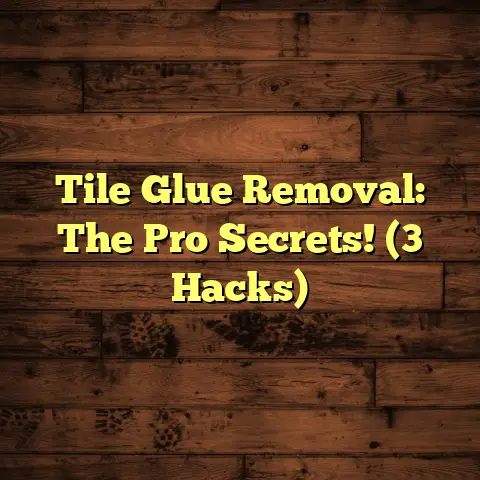Green Mold on Wood? (3 Steps To Kill It Fast!)
Imagine this: You’re picturing a cozy wooden cabin, nestled deep in a forest.
The scent of pine needles fills the air, promising relaxation and escape.
But then, the camera pans inside.
Instead of a warm, inviting space, you see it: Green mold.
Creeping along the wooden beams, staining the furniture.
That peaceful retreat?
Now a potential health hazard.
The comforting aroma?
Replaced by a musty, unsettling odor.
Green mold isn’t just unsightly; it’s a serious problem.
It can damage the wood, triggering allergies and more.
But don’t worry!
I’m here to help.
As a flooring contractor, I’ve seen this problem countless times.
And I’m going to share my tried-and-true method to eliminate green mold, quickly and effectively.
This article will arm you with the knowledge and steps to reclaim your space.
Let’s dive in!
Section 1: Understanding Green Mold
What is Green Mold?
Green mold isn’t a single type of mold.
It’s a category encompassing various mold species that appear green.
These molds thrive in damp, humid environments.
Think of places like leaky basements, poorly ventilated bathrooms, or areas with water damage.
Some common culprits you might find on wood include Cladosporium, Aspergillus, and Penicillium.
Each has its unique characteristics, but they all share that telltale green hue.
Mold needs certain conditions to flourish: moisture, a food source (like wood), and a suitable temperature.
Wood, being porous and organic, is a perfect breeding ground.
According to the EPA, mold can start growing in as little as 24-48 hours under the right conditions.
The Impact of Green Mold on Wood
Mold isn’t just a cosmetic issue; it can seriously compromise the structural integrity of wood.
Mold digests the wood, breaking down its fibers.
Over time, this leads to decay, weakening the wood and making it brittle.
Imagine a wooden support beam slowly rotting from the inside out.
That’s what mold can do.
Beyond structural damage, mold poses significant health risks.
Exposure to mold spores can trigger allergic reactions.
Think sneezing, coughing, itchy eyes, and skin rashes.
For people with asthma or other respiratory conditions, mold can worsen symptoms.
In some cases, certain types of mold can even produce mycotoxins, toxic substances that can cause more severe health problems.
According to the CDC, mold exposure can also irritate the eyes, skin, nose, throat, and lungs.
Identifying Green Mold
So, how do you know if you’re dealing with green mold?
First, look for the obvious: greenish or greenish-black patches on the wood surface.
The texture can vary, from fuzzy and velvety to slimy and slick.
Pay attention to the smell, too.
Mold often has a musty, earthy odor.
It’s a smell that’s hard to describe but instantly recognizable once you’ve encountered it.
Sometimes, it can be tricky to differentiate green mold from other types of mold or even just discoloration.
If you’re unsure, you can purchase a mold test kit at your local hardware store.
These kits allow you to collect a sample and send it to a lab for analysis.
Common signs of mold presence include:
- Visible mold growth
- Musty odor
- Water stains or water damage
- Peeling paint or wallpaper
- Warped or buckled wood
Section 2: Step 1 – Preparation for Mold Removal
Gathering Necessary Supplies
Before you start attacking the mold, you need to gear up!
Here’s a list of essential tools and materials:
- Gloves: Protect your hands from mold spores and cleaning solutions.
- Mask: An N95 respirator mask is crucial to prevent inhaling mold spores.
- Eye protection: Goggles or safety glasses will shield your eyes.
- Scrubbing brushes: Choose brushes with stiff bristles for effective cleaning.
- Spray bottles: For applying cleaning solutions.
- Cleaning solutions: More on this below.
- Buckets: For mixing solutions and rinsing.
- Rags or sponges: For wiping surfaces.
- Plastic sheeting: To protect surrounding areas from contamination.
- HEPA vacuum: For cleaning up mold spores after treatment.
Now, let’s talk cleaning solutions. You have a few options:
- Eco-friendly solutions:
- Vinegar: A mild acid that can kill many types of mold.
- Baking soda: A natural deodorizer and mild abrasive.
- Hydrogen peroxide: An effective disinfectant and bleaching agent.
- Commercial products:
- Mold killers: Follow the manufacturer’s instructions carefully.
- Bleach: Use with caution and proper ventilation.
I often recommend starting with vinegar or hydrogen peroxide.
They’re less harsh than bleach and still effective.
Ensuring Safety
Safety is paramount when dealing with mold.
Mold spores can be harmful, so you need to protect yourself.
Always wear gloves, a mask, and eye protection.
Open windows and doors to ensure proper ventilation.
If you’re working in an enclosed space, consider using a fan to circulate the air.
How do you assess the extent of the mold problem?
If the mold covers a large area (more than 10 square feet), or if you suspect it’s spread behind walls or under floors, it’s best to call in a professional mold remediation company.
According to the EPA, attempting to remove large areas of mold yourself can actually make the problem worse by spreading spores throughout your home.
If you have underlying health conditions, such as asthma or allergies, it’s also a good idea to consult with a doctor before tackling mold removal yourself.
Also, please note that in the United States, there are no federal standards for mold levels.
Preparing the Area
Before you start cleaning, you need to prep the area.
Clear out any furniture or belongings that can be moved.
Cover the floor and surrounding surfaces with plastic sheeting to prevent cross-contamination.
Use painter’s tape to secure the plastic in place.
This will help contain the mold spores and prevent them from spreading to other areas of your home.
If possible, seal off the affected room from the rest of the house.
This will further minimize the risk of spreading mold spores.
Think of it like creating a quarantine zone.
The goal is to contain the problem and prevent it from getting worse.
Section 3: Step 2 – Cleaning the Mold
Choosing the Right Cleaning Method
The best cleaning method depends on the type of wood and the severity of the mold growth.
For hardwood floors, you’ll want to be gentle to avoid damaging the finish.
For plywood or treated wood, you can be a bit more aggressive.
Here’s a step-by-step guide for using different cleaning solutions:
Vinegar:
- Pour undiluted white vinegar into a spray bottle.
- Spray the affected area thoroughly.
- Let it sit for at least an hour.
- Scrub the area with a brush or sponge.
- Rinse with clean water and dry thoroughly.
Hydrogen Peroxide:
- Pour 3% hydrogen peroxide into a spray bottle.
- Spray the affected area thoroughly.
- Let it sit for 10-15 minutes.
- Scrub the area with a brush or sponge.
- Rinse with clean water and dry thoroughly.
Baking Soda:
- Mix baking soda with water to form a paste.
- Apply the paste to the affected area.
- Let it dry completely.
- Scrub the area with a brush or sponge.
- Rinse with clean water and dry thoroughly.
Commercial Mold Killers:
- Follow the manufacturer’s instructions carefully.
- Apply the product to the affected area.
- Let it sit for the recommended time.
- Scrub the area with a brush or sponge.
- Rinse with clean water and dry thoroughly.
Applying the Cleaning Solution
When applying the cleaning solution, make sure you saturate the affected area.
Don’t be afraid to use a generous amount.
The goal is to penetrate the mold and kill it at its source.
Use a scrubbing brush to agitate the mold and loosen it from the wood surface.
Scrub in a circular motion, applying firm pressure.
Pay special attention to any cracks or crevices where mold might be hiding.
For particularly stubborn mold patches, you may need to repeat the cleaning process.
Don’t give up!
With persistence, you can eliminate even the most stubborn mold.
After scrubbing, rinse the area thoroughly with clean water.
It’s important to remove any remaining cleaning solution.
Use a clean rag or sponge to wipe the surface dry.
Make sure the wood is completely dry to prevent future mold growth.
Dealing with Residue and Stains
Even after cleaning, you may notice some lingering stains or discoloration.
Don’t worry; there are ways to tackle these issues.
For light stains, you can try using a wood bleach product.
Follow the manufacturer’s instructions carefully.
For more severe stains, you may need to sand the wood surface.
Use fine-grit sandpaper to avoid damaging the wood.
After sanding, you’ll need to refinish the wood to protect it.
Apply a sealant or finish that is specifically designed for wood.
This will help prevent future mold growth and protect the wood from moisture.
I recommend using a mold-resistant sealant or finish.
These products contain additives that inhibit mold growth.
They’re a great way to protect your wood and prevent future problems.
Section 4: Step 3 – Preventing Future Mold Growth
Controlling Humidity Levels
The key to preventing future mold growth is controlling humidity levels.
Mold thrives in damp, humid environments, so you need to keep the air dry.
Aim for a humidity level of 30-50%.
You can use a dehumidifier to remove excess moisture from the air.
Place the dehumidifier in the affected area or in a central location.
Make sure to empty the water reservoir regularly.
Proper ventilation is also crucial.
Open windows and doors to allow fresh air to circulate.
Use fans to improve airflow.
In bathrooms and kitchens, use exhaust fans to remove moisture.
Make sure your exhaust fans are properly vented to the outside.
Fix any leaks or water damage promptly.
Even small leaks can create a breeding ground for mold.
Inspect your plumbing regularly and repair any leaks immediately.
Clean up spills quickly and thoroughly.
Don’t let water sit on wood surfaces. Dry wet areas immediately.
Regular Maintenance Practices
Regular maintenance is essential for preventing mold growth.
Here’s a checklist of practices to follow:
- Routine inspections: Inspect your home regularly for signs of mold or water damage.
- Cleaning schedules: Clean bathrooms and kitchens regularly to remove moisture and prevent mold growth.
- Proper drainage: Ensure that your property has proper drainage to prevent water accumulation around the foundation.
- Landscaping: Trim shrubs and trees to allow sunlight and airflow around your home.
- Gutter maintenance: Clean your gutters regularly to prevent water from backing up and causing damage.
I recommend inspecting your home at least twice a year, in the spring and fall.
Pay special attention to areas that are prone to moisture, such as basements, bathrooms, and kitchens.
Choosing Mold-Resistant Materials
When renovating or building, consider using mold-resistant materials.
There are a variety of paints, finishes, and wood treatments that can inhibit mold growth.
Look for products that are specifically labeled as mold-resistant.
These products contain additives that prevent mold from growing.
They’re a great way to protect your home and prevent future problems.
When painting, use a mold-resistant primer and paint.
These products will create a barrier that prevents mold from penetrating the surface.
When choosing wood, consider using treated wood.
Treated wood is resistant to rot and decay, making it less susceptible to mold growth.
Conclusion
Dealing with green mold on wood can feel overwhelming.
But with the right knowledge and tools, you can tackle the problem effectively.
Remember the three essential steps: preparation, cleaning, and prevention.
By following these steps, you can eliminate green mold and prevent it from returning.
Don’t let mold ruin your beautiful wooden spaces.
Take action today and reclaim your home.
You have the power to create a safe and healthy living environment.
By controlling humidity, practicing regular maintenance, and using mold-resistant materials, you can keep mold at bay.
Don’t wait until the problem gets worse.
Address mold issues promptly and protect your home and your health.
You deserve to live in a space that is free from the perils of mold.
Take control and enjoy the peace of mind that comes with knowing you’ve done everything you can to combat green mold.
Go forth and conquer that mold!





